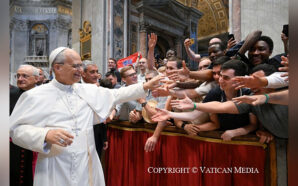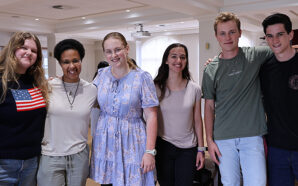Homily for the Fifteenth Sunday in Ordinary Time, Year C
Readings: Deuteronomy 30:10-14; Psalm 68 (69): 14, 17, 30-31, 33-34, 36-37; Colossians 1:15-20; Luke 10:25-37
10 July 2022
I’ve had a big week attending the Plenary Council of our Church. I was one of the periti – one of the so-called experts invited to observe proceedings and to provide advice when sought. A plenary council is a legislative body of the Catholic Church. There were up to 277 members in attendance. Those who were not bishops were able to cast consultative votes on motions. There were usually about 211 consultative voters in the room. There were 47 bishops and ‘ordinaries’ who held a deliberative vote. For a motion to get up, it required a two-thirds ‘yes’ vote of those with a consultative vote and a two-thirds ‘yes’ vote of the bishops. Members could vote ‘yes’, ‘no’, or ‘yes with reservations’ (placet juxta modum, to use the technical term).
LISTEN: https://soundcloud.com/frank-brennan-6/homily-10722
The week started on a high with several motions acknowledging the place and contribution of Aboriginal and Torres Strait Islanders in the life and liturgy of the Church, and affirming their place in the life of the nation. For example, the motion ‘endors(ing) the Uluru Statement from the Heart and encourag(ing) engagement with processes for implementing the statement, including local, regional and national truth-telling efforts’ was passed with 185 consultative voters voting ‘yes’, 4 voting ‘no’, and 20 voting ‘yes with reservations’. 44 bishops voted ‘yes’, with just 1 voting ‘yes with reservations’. No bishop voted ‘no’. It was a delight to hear the Aboriginal speakers on the floor of the assembly being so well received.
But then came the issue of ‘Witnessing to the Equal Dignity of Men and Women’. This is where things went very pear-shaped. The aim of the drafters of the motions was to reflect the concerns of church members who over the last four years of consultations had expressed views on the need to enhance the role of women in the Church and to overcome obstacles to equality if there was to be a true witnessing to the equal dignity of men and women.
The main motion attracted 148 ‘yes’ consultative votes, 36 ‘no’ votes, and 27 voting ‘yes with reservations’. This was enough to win the necessary two-thirds majority. But of the 47 bishops, only 25 voted ‘yes’ with 8 voting ‘no’ and 10 voting ‘yes with reservations’. The vote would have required 32 ‘yes’ votes from the bishops to succeed [1]. The room was dumbstruck. It wasn’t only women who were in tears. The assembly broke for morning tea. After the break, about 60 members, mainly women, spontaneously stood to the side of the hall and refused to take their places. The bishops were on notice that they could not simply proceed to the next item of business. It was no longer ‘business as usual’ [2].
A decision was made to listen to those who had taken a stand. Sr Ruth Durick OSU spoke for many when she said, “We acknowledge this as a disruptive moment which can also be seen as a gift of the Spirit. We also acknowledge the confusion caused by the number of [votes ‘yes with reservations’]. We call on the Plenary Council to affirm that the Catholic Church in Australia in 2022 will witness to the equal dignity of women and men.”
Over lunch, the bishops held their own meeting. About 90 others, including some of us periti, met in the library, listening particularly to the women who had taken a stand. One of the members, Emeritus Professor John Warhurst, reports the situation after lunch:[3]
“[T]hree women members of the ‘Library group’ gave a comprehensive report, while Bishop Shane Mackinlay reported on how the bishops planned to deal with the situation. After he did so I rose from the floor to ask why the bishops had rejected the motions. If the Assembly did not know this, then any further discussion was fruitless and a waste of time. I continued this discussion with the top table and later with Shane himself by text. No satisfactory answer, almost no answer at all, was forthcoming from anyone in authority.”
The bishops issued a media release saying:[4] “Plenary Council vice-president Bishop Shane Mackinlay … proposed that the members spend additional time discerning what reservations and concerns are being expressed” by the 10 bishops who had voted ‘yes with reservations’.
So the afternoon was spent with members having to surmise what might be the reasons in the minds of the 18 bishops who had voted ‘no’ or ‘yes with reservations’. Not one of those 18 bishops saw fit to inform the assembly of their reservations about the motion. Not one of those 18 bishops had the pastoral solicitude, moral courage, clarity of thought and expression to get to his feet and explain his misgivings. There was of course no legal requirement for any bishop to do so. But this was the moment for episcopal leadership. This was the moment for a pastor with the smell of the sheep to stand and lead the people from the wilderness.
It would have been for the good of the assembly and the good of the Church if even one of these bishops decided to forego the confidentiality of his vote and provide a solid basis for discussion of how things might be put right.
Archbishop Mark Coleridge, President of the Australian Catholic Bishops Conference, later told Geraldine Doogue: “Something had to happen, not just something to be said. You see the problem with explaining the vote, you run the risk of disclosing or disrupting the anonymity of the process. That’s an essential part. That was a bit of a difficulty.”[5]
In a synodal church, there are things that matter much more than the anonymity of bishops voting down a motion which would have left the plenary council saying nothing about witnessing to the equal dignity of men and women in the Church.
In his address at the opening of the Synod in Rome last October, Pope Francis said, “If we want to speak of a synodal Church, we cannot remain satisfied with appearances alone; we need content, means and structures that can facilitate dialogue and interaction within the People of God, especially between priests and laity. Why do I insist on this? Because sometimes there can be a certain elitism in the presbyteral order that detaches it from the laity; the priest ultimately becomes more a ‘landlord’ than a pastor of a whole community as it moves forward. This will require changing certain overly vertical, distorted and partial visions of the Church, the priestly ministry, the role of the laity, ecclesial responsibilities, roles of governance and so forth.”[6]
Everyone presumes that the major sticking point for the 18 bishops was that part of the motion which raised the possibility of women deacons. The defeated motion spoke of the Plenary Council committing the Church to ‘considering women for ministry as deacon – should Pope Francis authorise such ministry’. By Friday there were only 44 bishops voting. The new motion which passed with 37 ‘yes’ votes from the bishops proposed: ‘That, should the universal law of the Church be modified to authorise the diaconate for women, the Plenary Council recommends that the Australian Bishops examine how best to implement it in the context of the Church in Australia.’ It’s hard to see that the change in wording led to the mammoth change in ‘yes’ votes. We just don’t know, because none of the bishops who changed his vote thought it appropriate to tell us the reasons for the change of vote.
All other motions on Friday which were derived from the originally rejected motion on Wednesday attracted even more support from the bishops, most parts winning their approval by 43 to 1. The bishops had clearly come to their senses realising the enormity of what they had done on the Wednesday. Bishop Shane Mackinlay was masterful in the way he led his fellow bishops back from the precipice.
There were all sorts of murmurings about the drafting of the Wednesday motion. For example, there had been suggestions that the Wednesday motion spoke too simply and misleadingly about Pope John Paul’s 1995 letter to women. The Wednesday motion stated:
“Pope Saint John Paul II acknowledged in his Letter to Women, the Catholic Church has been ‘conditioned … to a remarkable extent’ by a history in which ‘women’s dignity has often been unacknowledged, and their prerogatives misrepresented’. He called the Church to work to overcome the cultural assumptions of inequality”.
The new motion was fleshed out to state:
“In his Letter to Women, Pope Saint John Paul II apologised for harm caused to women, and he called us to ensure the personal dignity and rights of women are protected and upheld as well as recognising the unique gifts they contribute to building up a healthy Church and society. In particular, he called us to work to overcome the cultural assumptions of inequality:
‘Women’s dignity has often been unacknowledged and their prerogatives misrepresented; they have often been relegated to the margins of society and even reduced to servitude. This has prevented women from truly being themselves and it has resulted in a spiritual impoverishment of humanity. Certainly it is no easy task to assign the blame for this, considering the many kinds of cultural conditioning which down the centuries have shaped ways of thinking and acting. And if objective blame, especially in particular historical contexts, has belonged to not just a few members of the Church, for this I am truly sorry.'”[7]
27 years on from the papal letter, our bishops cannot deny that our Church has often been to blame for the failure to acknowledge the equal dignity of men and women.
In today’s Gospel, we hear the parable of the Good Samaritan. Scripture scholar Luke Timothy Johnson reminds us, “This is not a sentimental tale.” Johnson speaks of the recognition that Jews “dedicated to holiness before the Lord would allow considerations of personal safety or even concern for ritual purity (a corpse defiled) to justify their not even crossing the road to look. They ‘pass by on the other side.’ If love for neighbour meant anything, it meant to care for” one’s own. A shock “is the discovery that a despised Samaritan, himself most at risk in this dangerous no man’s land of deserted territory, takes the chance of stopping, looking, and—increasing his own vulnerability—leading the man on his beast to an inn. It is the hated enemy who is the hero with a human heart.”[8]
Thank God for those in the room, including some of our bishops, who witnessed the women by the side of the road on Wednesday, tending their wounds, hearing their pain, and discerning the disruptive presence of the Spirit. Business as usual can no longer mean our bishops remaining silent when they vote down a motion aimed at acknowledging the equal dignity of men and women in our Church and in society.
Turn to the Lord in your need, and you will live.
This is our prayer to you,
our prayer for your favour.
In your great love, answer us, O God,
with your help that never fails:
Lord, answer, for your love is kind;
in your compassion, turn towards us.
Turn to the Lord in your need, and you will live.
As for us in our poverty and pain
let your help, O God, lift us up.
We will praise God’s name with a song;
We will glorify him with thanksgiving.
Turn to the Lord in your need, and you will live.
Fr Frank Brennan SJ is the Rector of Newman College, Melbourne, and the former CEO of Catholic Social Services Australia (CSSA). He has been appointed a peritus at the Fifth Plenary Council of the Australian Catholic Church.
[1] There was another motion which provided: ‘That each Australian diocese and eparchy foster new opportunities for women to participate in ministries and roles that are stable, publicly recognised, resourced with appropriate formation including theological education and commissioned by the bishop. These ministries and roles should engage with the most important aspects of diocesan and parish life and have a real impact on those communities.’ This motion did not receive a 2/3 majority even with the consultative voters. In fact, the consultative vote was 84 ‘yes’, 31 ‘yes with reservations’ and 97 ‘no’. The bishops in their deliberative vote were more in favour, though failing to give a 2/3 affirmative vote. They voted 27 ‘yes’, 5 ‘yes with reservations’ and 11 ‘no’.
[2] See Archbishop Mark Coleridge quoted in, ‘Episcopal autocracy “has to go”– Australia Plenary Council’, The Tablet, 4 October 2021, at https://www.thetablet.co.uk/news/14573/episcopal-autocracy-has-to-go-australia-plenary-council
[3] John Warhurst, ‘Plenty of Spin’, Blog No 16, Wednesday 6 July 2022, at https://mailchi.mp/e22e88e610e7/newsletter-31-january-13629708?e=69ce496340
[4] ‘Deeper discernment invited during Plenary Council’, 6 July 2022, at https://mediablog.catholic.org.au/deeper-discernment-invited-during-plenary-council/
[5] Geraldine Doogue, Plenary Matters Podcast, 8 July 2022 at 12:01 -, available at https://open.spotify.com/episode/1tGotFm5xVR4tKxhtBpiuf
[6] Address Of His Holiness Pope Francis For The Opening Of The Synod, New Synod Hall Saturday, 9 October 2021 at https://www.vatican.va/content/francesco/en/speeches/2021/october/documents/20211009-apertura-camminosinodale.html?fbclid=IwAR3hDM-Oacksjs3mco5Mlte5nYFMbQyXgBeJktINZbRIDQbBTXH-WLMe9b4
[7] Pope John Paul II, Letter to Women, 29 June 1995 1995, n.3 at https://www.vatican.va/content/john-paul-ii/en/letters/1995/documents/hf_jp-ii_let_29061995_women.html
[8] Luke Timothy Johnson, The Gospel of Luke, Sacra Pagina Series (Collegeville, MN: The Liturgical Press, 1991), p. 175.








